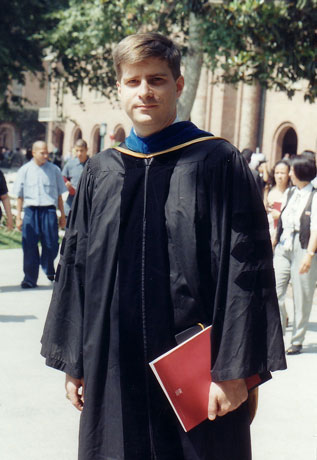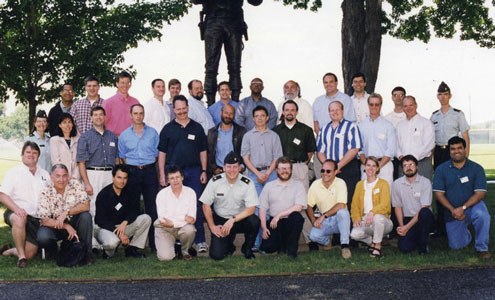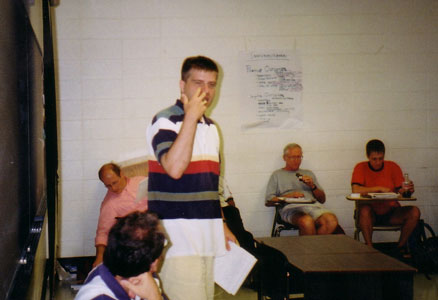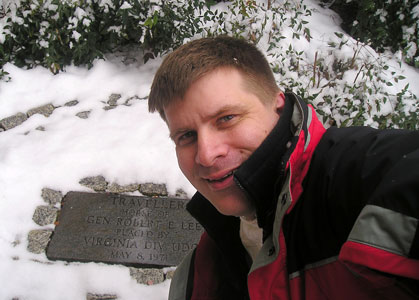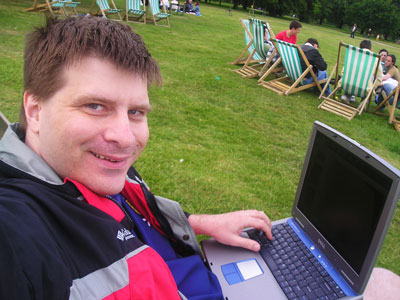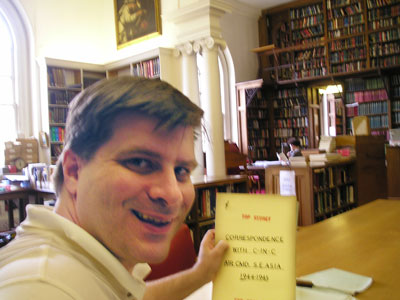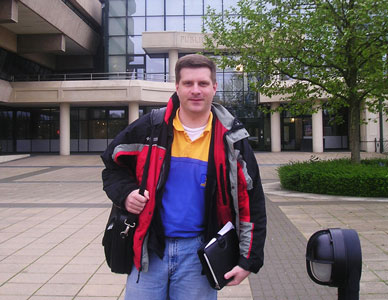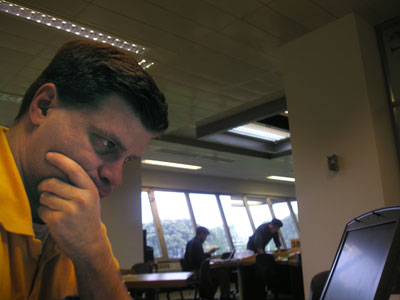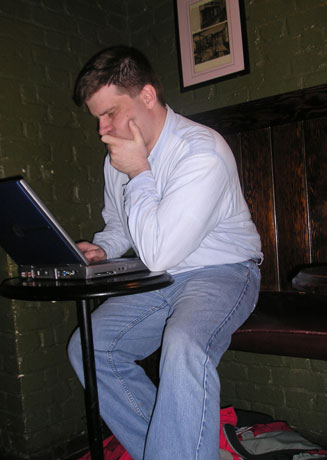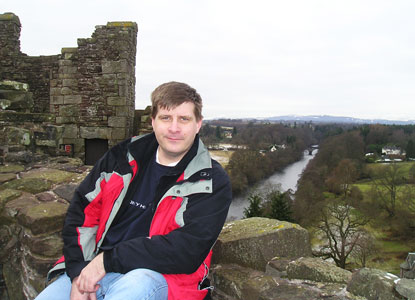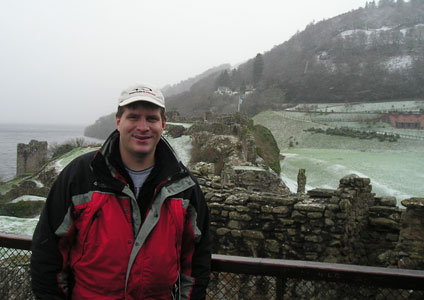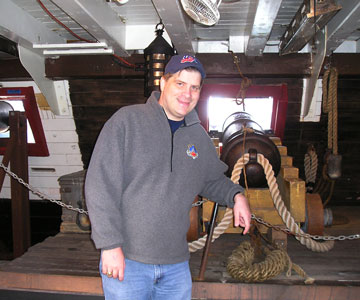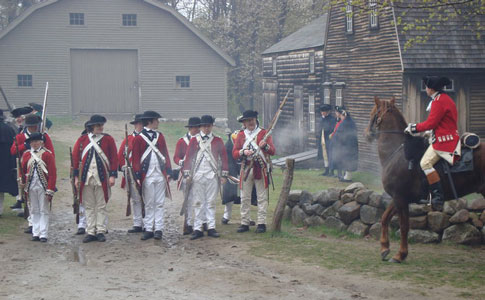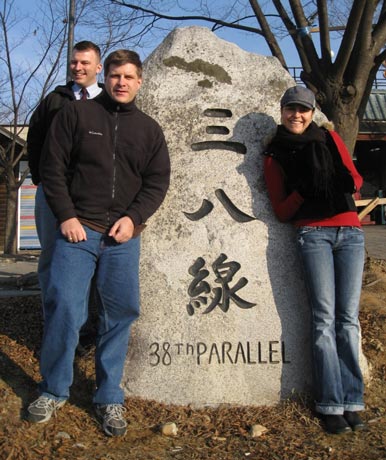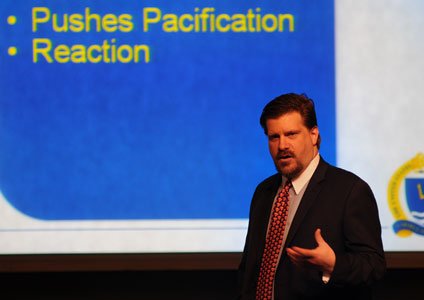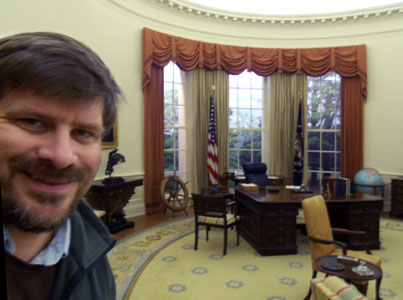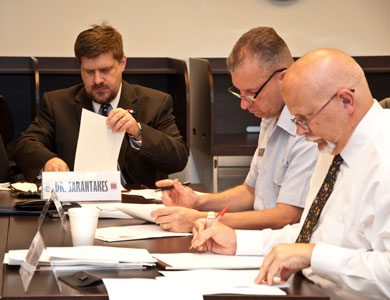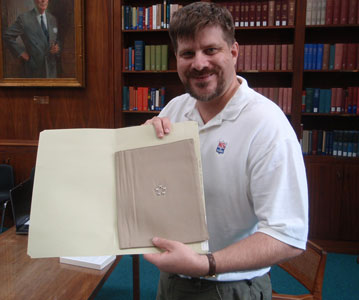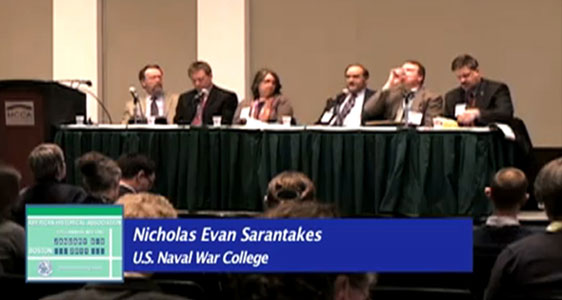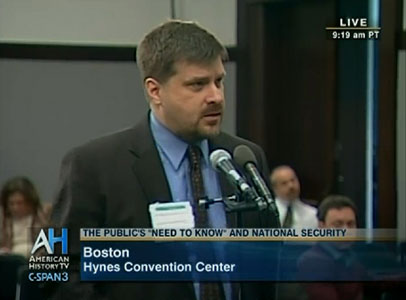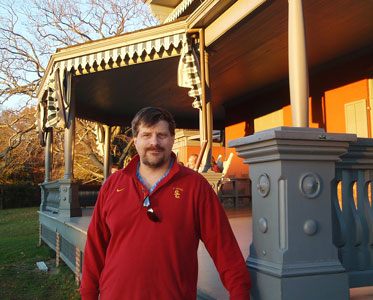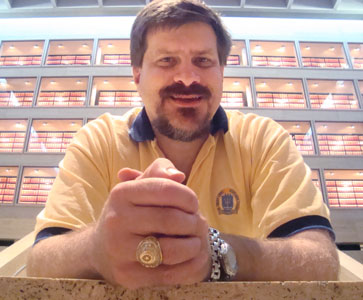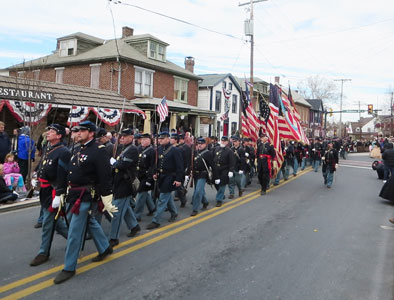Photo Gallery
Young Historian: Somewhere at a Civil War battlefield.
Ambition: The writing bug strikes some of us sooner than others.
World Famous Literary Ace: Every good writer needs a role model.
Trojan: Sarantakes at the 1997 graduation exercises at the University of Southern California where he received his Ph.D. in history.
West Point: In the Summer of 1999 Sarantakes was a Fellow in the West Point Summer Seminar in Military History. First Row: John Weinzierl, Hal Sweet, Daniel Kowalsky, Jean Paquette, Maj. James L. Haynesworth, James Levy, Salvatore Mercogliano, Jennifer Speelman, Stan Adamiak, and Larry Valero; Second Row: Maj. Kelly Hoepfner, Jacqueline McGlade, Thomas Berg, Barry Stentiford, John Lavalle, John Beeler, Galen Perras, Bob Wettemann, Jonathan Phillips, Tom Mays, and Maj. David M. Toczek; Third Row: Michael Creswell, Van Mobley, Ethan Rafuse,John Harvey, Everett Dague, Jeffrey Engel, Claude Hargrove, George Vourljianis, Chuck Steele, Sarandis “Randy” Papadopoulos, and Mark H. Danley: Fourth Row: Gen. George S. Patton, Jr.
Nixon and Sports: In the summer of 2000 Sarantakes took part in a National Endowment for the Humanities Summer Seminar in Sport History. Here he is giving a presentation on his research on Nixon and Sports.
Baseball: The NEH Summer Seminar took place in Chicago. The participants took in a game at Wrigley Field.
Grave Side: Research for Making Patton required four separate trips to the Virginia Military Institute to consult the papers of Frank McCarthy, the producer of the film. During the second trip, Sarantakes visited the grave of Robert E. Lee and his horse Traveler.
Salford: Sarantakes and Larry Valero eating lunch at the University of Salford in 2004. Valero was the host for Sarantakes while he had a visiting fellowship at Salford, which is located just outside of Manchester, England. The five months he spent in the United Kingdom were enormously productive and altered his career in many ways. Crescent House, where their offices were located, is visible in the background.
Dublin Castle: Sarantakes was in Ireland in 2004 to do research for what became his article "Green Politics, Green and Orange Diplomacy: Lyndon Johnson and Eamon de Valera's Farewell Tour of the United States" in the journal Diplomacy and Statecraft. The article won a writing prize: the Silver Pen Award from the Command & General Staff College. The castle was the headquarters of British administration in Ireland. The Norman Tower in the background dates back to the 13th century. The castle is now home to offices of the Dublin municipal government.
Kensington Park: Writing Allies against the Rising Sun in a lawn chair somewhere in the park during 2004.
Historian at Work: Doing research in 2005 at the library of Christ Church College at the University of Oxford in the papers of Sir Charles Portal for Allies
Against the Rising Sun. Portal was the head of the Royal Air Force during World War II. This trip was the last of five that Sarantakes made to England to do research for this book. Notice the “Top Secret” designation on the folder cover.
Kew Gardens: Outside the British National Archives, formerly known as the Public Record Office.
Historian as Researcher: Doing research in the British National Archives in 2005 for Allies against the Rising Sun.
Writer at Work: In the Ye Olde Cheshire Cheese pub. Known as a writer's place, Charles Dickens, Alfred Tennyson, and Sir Arthur Conan Doyle frequented this establishment. Sarantakes is writing an article on Anglo-American relations.
The Knutson Incident: In 1944 Lieutenant General George S. Patton, Jr. during a visit to Knutson, England to open an officers' club made a comment about the Americans and British running the post-war world. This comment became a major media crisis that nearly derailed his military career. This site is where that speech took place and is also where the scene depicting the incident in the film Patton was filmed.
Castle Doune: Sitting atop the Scottish castle with the River Teith in the background. Although the fortress was an important military location in Scottish wars against the English, it is now best known as the location for the filming of Monty
Python and the Holy Grail.
Castle Urquhart: This fortress was destroyed in the 17th Century during the Scottish effort to put the Catholic Stuarts back on the thrones of England and Scotland. The water in the background is Loch Ness.
Inside the B-39: There is something to be said for actually visiting the historical locations. For naval history, that means touring ships more
than visiting an empty spot of water. In this case, this Soviet diesel electric submarine is berthed in San Diego. It is what the Soviet Navy called
a Project 641 submarine, but were better known in the United States by its NATO designation as the “Foxtrot” class. The “Foxtrots” are basically
larger and more powerful versions of German World War II era U-boats.
The HMS Surprise: The Surprise is a replica of a British frigate from the 1750s. The ship was actually built in 1970 and was the set for the 2001
film Master and Commander: The Far Side of the World.
The Skier: Historical research requires travel to various different archives. Sometimes side trips can be added on to those academic expeditions. After doing research in the archives of the U.S. Olympic Committee for his book Dropping
the Torch, Sarantakes used an extra day to hit the slopes at Breckenridge, Colorado.
Historical Tourist: Every year people reenact the Lexington and Concord battles. These events often deliver many intangibiles about the past that
documents fail to deliver. Back in 1775 the British Army marched out of Boston to Concord and then after taking heavier than expected casualties,
the red coats marched back. Along the way, small groups of militia (the “minute men”) shot at the retreating troops. The Battle of the Bloody Angel
was fought in front of Hartwell Tavern. Here American militia men form in front of the tavern. Sarantakes is the only person in this photo wearing
clothing from the Twenty-First Century.
Time Travel: This photograph is far more realistic of something you would have seen in 1775. Here the American militia musters in front of Hartwell Tavern.
The Fog of War: Here the British forms on the west side of Hartwell Tavern. In this photograph the smoke of the black powder is readily visible. There were about only 200 people at this reenactment, but there were probably about 2000-3000 people on both sides of the battle in 1775. The smoke would have been much thicker, probably like really thick fog.
In Korea: Sarantakes with his brother, Maj. Andrew T. Sarantakes and his sister, Katie Sarantakes Scallon at the 38th Parallel, the line that
divided North and South Korea at the beginning of the Korean War.

In the Navy: The USS Toledo (SSN-769) is a Los Angeles-class submarine stationed in Groton, Connecticut. In 2010 Sarantakes and his Naval War
College Students took a real tour—not like some of the museum ships that allow you to only go through one deck of the ship—but the entire submarine,
including the periscope. The dominate impression people had from the tour is the tightness of quarters. From Left to Right: CDR Mery-Angela S. Katson,
U.S. Navy; CAPT Bethel F. Asante, Ghana Navy; CDR Pavlos Panagiotopoulos, Hellenic Navy; LCDR Thomas H. Shugart III, U.S. Navy; LCDR Sean P. Loofbourrow,
U.S. Navy; Col Lloyd I. Terry Jr., U.S. Air Force Reserves; Dr. Nicholas Evan Sarantakes, Ph.D.; COL John J. Strycula, U.S. Army; LCDR Jill R Cesari,
U.S. Navy; LtCol Matthew R. Crabill, U.S. Marine Corps; Lt Col Byron B. Anderson, U.S. Air Force; CDR Aristides G Reyes, U.S. Navy; David P. Every
of the U.S. Merchant Marine; Col. James C. Brennan, U.S. Marine Corps; CDR Richard M. Stacpoole, U.S. Navy; Alfred R Magleby, U.S. Department of
State; and LCDR Charles R. Dwy JR, U.S. Navy.
Vietnam, Vietnam, Vietnam: A key component in the Strategy & Policy course at the Naval War College are the lectures that faculty deliver for each lesson. In 2010 Sarantakes gave a talk on why the United States never reconsidered its strategy during its war in Southeast Asia. The main reason: the Americans faced enormous institutional, political, and civil-military issues that confused them and led them to believe there was little need—they thought they were winning.
Conference: The Strategy & Policy Department at the Naval War College sponsors a conference on how to teach strategy. A number of scholars at other institutions are brought to campus for several sessions that explore the various issues faced in teaching a topic that is part history and part political science. John Maurer, the chairman of the department throws out some issues to discus while Hal Brands of Duke University and Jeremi Suri of the University of Wisconsin listen.
The Room of Rooms: Sarantakes standing in the Oval Office, or in a full-scale reproduction of the room when Gerald R. Ford was President, which is housed at the Gerald R. Ford Presidential Museum. Take your pick.
The Judge: In 2007 Sarantakes won the Kiley Prize for the best article published in Joint Forces Quarterly. This award is part of a strategic essay competition that the Chairman of the Joint Chiefs of Staff and the Secretary of Defense sponsor. As a way to pay back for winning this award, Sarantakes has served as a representative from the Naval War College several times during these two day grading frenzies.
Five Stars: Research for Making Patton required four separate trips to the Virginia Military Institute to consult the papers of Frank McCarthy, the producer of the film. McCarthy also produced MacArthur and during the fourth trip, Sarantakes found this script cover from that production.
AHA 2011: Part of the job of a historian is attending academic conferences. At the annual meeting of the American Historical Association, Sarantakes participated in a session on the job market. His position was that the problems historians face is one of simple economics. Supply vastly exceeded demand with supply being people with a history Ph.D. and demand being jobs available for them. Sarantakes is located at the end of the table on the right.
Documents: Another session at the AHA meeting focused on the leak of classified information on Wikileaks. Sarantakes was one of a number of people that asked questions from the floor as this well attended session wrestled with the significance of the material. A rough consensus that emerged was that most of the leaked material amounted to a governmental version of gossip.
The Summer White House: Visiting important locations in history can be important to give a historian a feel for the size, shape and scale of people
and events. Here Sarantakes is standing in front of Theodore Roosevelt’s private residence, Sagamore Hill.
LBJ Scholar: Austin, Texas is Sarantakes’ hometown and when he visits he always visits the Lyndon Baines Johnson Presidential Library. As a result,
he has written a number of articles on U.S. diplomatic history during the 1960s. He is part of a small group of scholars that argue that LBJ did
much better in foreign policy than one might thing, particularly given his failures in Vietnam. This photo was taken in the atrium of the Library
and the red boxes in the background hold unclassified White House documents.
Remembrance Day: Civil War reenactors commemorate the Gettysburg Address every year with a parade in Gettysburg, Pennsylvania. The parade in 2013
honored the 150th anniversary of the speech and it had approximately 5,000 participants. Reading documents gives one a feel for the past, but in
a very real sense, the parade made history came alive that day in a way that the written record cannot provide.



